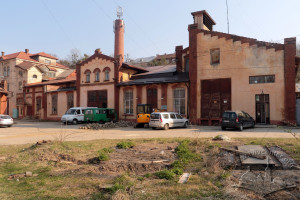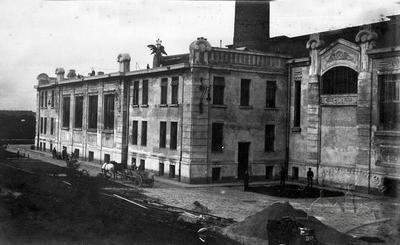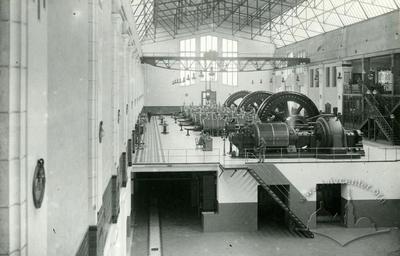Vul. Kozelnytska, 5 – Lviv Heat and Power Plant No. 1 ID: 2669
Heat and Power Plant No. 1 supplies heat and hot water for some southern areas in Lviv. It functions on the basis of the alternating current power plant, which had been put into operation in 1909 under the direction of Józef Tomicki. During WWII most of its equipment was taken away or destroyed by the Nazis. Its was restored using the equipment brought as war indemnity after the victory over Nazi Germany. The power plant reached its maximum capacity of 60 MW in the late 1950s. Following the Dobrotvir power plant construction, it was switched to the heat supply mode.
Story
Owing to the city's income from the work of the Municipal Electric Facilities (MEF) in 1896-1905, Lviv Magistrate decided to expand its tram routes and the electricity supply network. Electric lighting of the houses became more and more desirable among the Lviv residents. However, the carrying capacity of the city's direct current grid reached its limit already in 1902. The DC power plant on Wulecka street (today, vul. Sakharova) was designed to connect, apart from the tram, 6,000 lamps with a capacity of 50 W each, that is, 300 kW. In 1905, the total connected capacity of the DC electric grid consumers was already 316 kW, and by 1908 it reached 490 kW, that is, much more than its optimal occupancy. The further expansion of the DC grid to the distant parts of the city was not reasonable because of the inability to provide the necessary voltage level.
Józef Tomicki, director of the MEF in 1897-1925, recalled, "the tram routes and the electricity network covered only certain parts of the city, so remote suburbs quite rightly sought means of transport communication and electrification of their homes." In 1905 the Magistrate instructed him to work out technical and financial possibilities for the implementation of new plans. Only 4 million crowns were allocated for the expansion of the existing power plant and network, though.
In despair Józef Tomicki sought support from Roman Dzieślewski, a professor at the Lviv Polytechnic and a permanent member of the Municipal Electricity Commission. Their collaboration or rather an engineering adventure in 1906, yielded results. Having Dzieślewski's support in advancing the alternating current idea, Tomicki suggested that the Magistrate should send the project to Vienna for a technical audit. The Magistrate asked Alex Kern, the former director of the Lviv electric tram in 1894-1897, to lead the examination. Tomicki previously spoke with Kern about his problems. Kern recalled that he had discussed with Tomicki the possibility of using the existing DC cable lines for the 110 V AC grid, as well as the groundwork done by the MEF with respect to the construction of new power plants. In these materials, Tomicki and the MEF directorate considered two sites for a future power plant: at Bilohorshcha, 7 km from the city, for the construction of a three-phase current power plant, and the Pełczyński lakes for DC power plants.
At the suggestion of Roman Dzieślewski, a special committee was set up to expand the MEF, which, in addition to Roman Dzieślewski, included Józef Tomicki and Alex Kern. At a meeting of the committee on 10 October 1906, a decision was reached to abandon the direct current system. The remoteness of the power plant on Sakharova street from the railway was put forward, as it complicated the fuel supply. Alex Kern suggested building a new AC power station at Persenkówka, a suburban area, near the Lviv-Stanislaviv-Chernivtsi railway track. The committee appealed to the Magistrate with a budget of 11.8 million crowns, much more than previously anticipated. According to Tomicki, "the need to expand the MEF was becoming more and more obvious and urgent, so the City Council finally decided to provide the necessary loans for the amount of 10 million crowns, and when this amount was spent in the course of works, another amount of 4 million was added, 14 million crowns in total." On 30 November 1906, the Magistrate appealed to the Viceregency apropos of a project to expand the electric tram in Lviv. Józef Tomicki was the spokesman, while Roman Dzieślewski took part as well. At this meeting, a final positive decision was taken. Intensive work began. In November 1908, the first two generators with a capacity of 1500 horsepower (hp) each were delivered to Lviv from the Škoda plant in Plzen, and the official consecration of the new power plant took place on 18 February 1909. The total capacity of the power plant was 6000 hp or 4500 kW.
Initially, the Lviv power plant was supplied with fuel oil from Boryslav. In 1913 Józef Tomicki suggested replacing this expensive fuel with coal. His memorandum for the Magistrate dated 10 May 1913 is kept in the State Archive of Lviv Region, containing a detailed description of the necessary equipment and the calculation of payback. In 1914 the power plant was switched over to coal imported from Silesia. Both types of fuel did not satisfy the Lviv city leaders in terms of environmental safety. Rare trees planted in the Stryiskyi Park suffered particularly. After the gas pipeline Dashava-Lviv was built in the late 1920s, the power plant was switched over to natural gas.
In 1913 two turbogenerators with a total capacity of 6 MW and three steam engines with a capacity of 1.1 MW were installed at the plant. Water for cooling was supplied from the Żelazna woda (Zalizna Voda) springs and from the stream of Sofiówka (Sofiyivka).
During the battles for Lviv in November 1918, the power plant and the city cable grid suffered damage. However, even in the hard time of an armed confrontation, there were conscious people on both sides, who considered the safety of civilians and their right to a decent life, including the uninterrupted supply of electricity to the city, to be above all. On 19 November 1918, at 10 a.m., captain Osyp Bukshovanyi, a representative of the Ukrainian army command, and Ludwik de Laveaux, a Polish commanding officer, made an agreement according to which the power plant at Persenkówka and the gas station on Źródlana (now Dzherelna) street were declared extraterritorial. Joint commissions consisting of three Ukrainian and three Polish representatives were present at these municipal enterprises constantly.
From November 1918 till May 1919, the power plant did not produce energy. Apart from the damage, emergency blackouts in the city's power grid added to this. Cable lines and transformer substations were also damaged because of street fighting. According to the memoirs of Józef Tomicki, as early as eight days after the ceasefire, the power plant was repaired and put into operation. Its capacity was constantly increasing and reached 19500 kW in 1925.
All suburban villages were to be included into Lviv in 1930. It was considered thus to convert the power plant into a regional one, and to construct electric lines to the towns of Żółkiew (Zhovkva), Jaworów (Yavoriv) and, most importantly, to the water pumping stations. As electric pumps were installed at the station in Karaczynów (Karachyniv) and at the wells in Wola Dobrostańska (Volia Dobrostanska), Szkło (Shklo) and Wielkopole (Velykopole) it became possible to provide Lviv with water all round the clock.
The power plant's modernization could not keep pace with the accelerating expansion of the electricity grid. It was more a question of distributing equipment, rather than the generating one. All 5 kV equipment was designed for a maximum capacity of 4.6 MW. The grid reached such a capacity in 1921, and in 1925 the total consumption became 7.1 MW. Lviv Magistrate invited the Warsaw power plant's director to conduct an audit of the MEF in regard to their profitability. He noted in the report dated 27 February 1928 that, "taking into consideration the example of large European cities, I can say that electricity consumption in Lviv will grow, and one of the factors restraining this process will be the 5 kV distributing equipment, which is completely worn out and in critical condition. The importance of its replacement can be emphasized by the explosion of an oil switch at the power plant in Chorzów."
During 1929, the 5 kV distributing equipment and the power plant's control panel were transferred to a new building; old switches were replaced by new ones made by the Siemens-Schuckert company.
In 1932 the electrification of localities outside Lviv started, and the power-producing capacity of the power plant was increased to 26 MW.
Retreating in 1944, the Germans removed three turbogenerators from the power plant. Two of them, with a total capacity of 12.4 MW, were in the best condition among the five available at the beginning of the war. The third one, completely new, with a capacity of 16 MW, was established during the Nazi occupation. Besides, two transformers 5/30 kV, which transmitted electricity to the Lviv district 30 kV grid, were taken from the power plant and sent to Germany. The rest of the equipment and facilities were destroyed by explosions of nine high-explosive bombs laid by the Nazis in various places of the power plant. The explosion damaged generating equipment and burnt three cooling towers. Approaches to the power plant were mined.
As of 27 July 1944, when the Soviet troops captured Lviv, the municipal power plant did not work. Lviv and the region remained virtually without light. 12 days later, on 8 August 1944, a 0.5 MW turbogenerator was put into operation, and by the end of the year a 0.5 MW railway mobile power plant was delivered. As a result of the destruction, at the end of the Second World War the total capacity of the Lviv power plant decreased from 40 MW (6 generators) to 1 MW as of 1 January 1945.
To settle the urgent issue of restoring generating capacity, equipment was brought from a German power plant as a contribution for the damage incurred during the war.
The transitional base of trophy power plant equipment was located in Lviv in four different places with a total area of over 15 hectares. The equipment was unloaded and loaded by electrical supply network workers, military men and German prisoners of war. The equipment delivered to the Lviv component base was then transported to various Soviet power plants. Blechhammer power plant's equipment was sent to the Chelyabinsk heating plant, from the area of Heydebreck — to the heating plant in Lysychansk, from Krapets (an unidentified locality mentioned in archival documents) — to the Zuyivska heating plant, from the town of Oświęcim — to the heating plant in Kemerovo, from the Wilhelm and Walter electric power stations — to the Shterivska power plant. At the Lviv power plant, there was equipment taken from the power plant in Odertal (Deschowitz-Beuthen/Zdzieszowice).
In 1945, to compensate the lack of electricity, the city had to supply it from the Drohobych power plant using a 110 kV line. In the same year, 12 MW trophy generating equipment was established at the Lviv power plant and three General Electric railway mobile power plants were delivered, with a total capacity of 7.5 MW.
Restoring the generation of electricity was to be done without delay. To stimulate the workers, the manager of the Lviv Energy Complex Oleksiy Kucheruk appealed to the People's Commissariat of Power Plants of the USSR to allow him to give them "4,000 liters of vodka, 100 kilograms of tobacco and 10,000 coupons for an additional second hot meal", which, during the postwar period of total deficiency, was a very important argument for the workers.
In 1946 two more turbogenerators with a capacity of 12 MW and 4 MW were put into operation at the Lviv power plant.
Now, there was not enough water at the power plant. In 1946-1948, a reservoir on the Shchyrets river was built in the village of Navariya (today it is the Hlynna Navariya lake), from where a water supply system was to deliver water to the Lviv power plant. Various doers were involved: geologists came from Kharkiv; drilling equipment was brought from there as well; nails and bolts came from Dnipropetrovsk (now Dnipro), cement was from Zdolbuniv, and coal came from Stalino (now Donetsk).
During 1949 the installed capacity of the Lviv power plant increased to 45.5 MW. Gas supplied from the Dashava gas field covered 91% of the fuel needs, and 9% were covered by coal from Silesia.
The maximum power of 60 MW was reached by the Lviv power plant in the late 1950s. After the construction of the 700 MW Dobrotvir power plant, the value of the Lviv power plant for the power supply of the region decreased and in 1960 it was switched over to the heating mode (Lviv heat and power plant 1). It is from this plant that the residents of the areas of Naukova and Volodymyra Velykoho streets, Sykhiv and Novy Lviv are supplied with heat and hot water. At present, the plant functions in the "cogeneration" mode (simultaneously produces thermal and electric energy), which is considered the most economical use of fuel resources.
Related buildings and spaces
People
Stanisław Kozłowski (1888-1939) — manager of the Lviv power plant in
1923-1932, deputy director of the MEF in 1932-1935, director of the MEF in
1935-1939;
Taras Krukenytskyi — controller,
senior controller of the Lviv power system in 1960-1979, director of the Lviv
city electric grids in 1979-2002.















